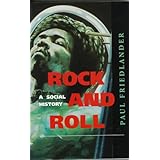
Average Reviews:

(More customer reviews)There is no shortage of books purporting to give historical accounts of American rock and roll music. From trade paperbacks to more scholarly treatments (like Steve Waksman's "Instruments of Desire") these texts vary widely in scope and quality. Paul Friedlander's "Rock and Roll: A Social History" is one of the better treatments of this music, although it suffers from some difficulties. Published on Westview Press, the book is written by a musician turned academic historian, and is targeted towards an intelligent readership, although not necessarily towards the strict academician.
The book exhibits a number of strong points, including an opening essay providing a hermeneutics of rock and roll, focusing on open-ended readings of both music and lyrics, while acknowledging the biases and cultural positioning of the critic. Friedlander avoids exclusivist and reductionistic modes of analysis, instead arguing for pluralistic elements of both "escape" and "enlightenment" in popular music. This allows him to maintain a critical distance, but avoids a simplistic overgeneralization of the subject matter, as seen in both left-wing music critics like Theodore Adorno and right-wing critics like Orrin Hatch.
The bulk of Friedlander's book, however, focuses on tracing a narrative of influences from artist to genre and back again. While useful, this reveals a limitation on Friedlander's part, a subterranean impulse to regard the history of music as a history of artists. While the fetishizing of the "artist" is nothing new (dating at least from the publication of "Sentimental Education" by French realist Gustav Flaubert) it deserves to be interrogated and examined, especially in a text claiming to be a "social history."
Friedlander's narrative progresses from a largely white middle class phenomenon in the early fifties, to an infiltration of urban R +B into the musical sensibilities of white teens. Friedlander is careful to analyze the appeal of early artists in terms of race and sexually rebellious theme, as in the case of Little Richard and Jerry Lee Lewis as compared to Elvis Presley. Friedlander devotes complete chapters to supergroups, and artists, like The Beatles, Rolling Stones, and Bob Dylan, while chronicling the interplay of Soul and Motown music with issues race. Later chapters are devoted to themes of "decades" (70's, 80's) while punctuating these chapters with genre examinations, such as Punk Rock and Folk Rock. The attention given to race as a guiding issue in rock and roll music is admirable, even if some of the particular conclusions are debatable-here Friedlander shows himself superior to many other treatments of the subject, which often ignore Soul, Motown or post-50's R+B altogether.
Another strength of the book is an extensive discography of the artists covered (and skipped too) in the book. Again here Friedlander rises above others in his careful treatment and guidance to the reader regarding label reissues, as well as refusing to fetishize the "original album" as the proper unit of record collecting (a fairly recent and annoying trend). At the same time, Friedlander's endnotes are frustrating, leaving very few openings to track down interpretations and influences in his own writings.
In the final analysis, "Rock and Roll : A Social History," is a valuable but insufficient introduction, especially with regard to social issues other than race. An excellent place continue reading is Steve Waksman's "Instruments of Desire," an excellent cultural history of the electric guitar.
-Christopher W. Chase, PhD Fellow, Michigan St. Univ.
Click Here to see more reviews about: Rock And Roll: A Social History
Click here for more information about Rock And Roll: A Social History

0 comments:
Post a Comment